
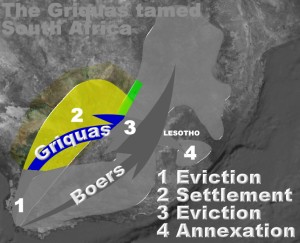 |
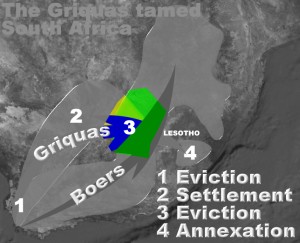 |
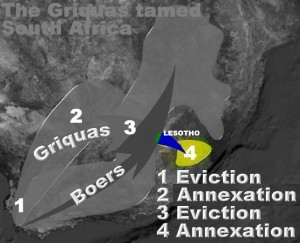 |
Previous Page |
The history of the Griquas in a Map (click) |
Next Page |
Life was hard and dry at Griqua town and the Griquas sought better pastures for their growing herds of sheep and cattle fortuitously a London Missionary Society Missionary, Dr Philip, would come to their aid. (A detailed history of life at the settlement at Griqua Town can be seen at this link (1801 to 1871)
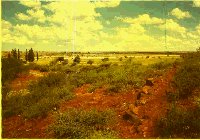 Image
right: the desolate vegetation around Griqua Town - today.
Image
right: the desolate vegetation around Griqua Town - today.
"The Cape Records relative to the condition and treatment of the native tribes of South Africa from an inquiry" by Donald Moodie (published 1841) records:
At a single stroke of the unscrupulous pen of the representative of the London Missionary Society (Dr Philip) contributed to from the highest and best of motives by many of the most enlightened, religious and humane community in the world, to Adam Kok's own plundering and murderous Bergenaars are, for the protection of the Bushmen ! converted into Griquas and the Bushman territory into the "Griquas' own country". (Dr Philip ceded the land now known as the Orange Free State to the Griquas in the early 1800s in an attempt to keep the land from the Voortrekkers who enslaved the blacks)
The Griqua's jumped at the opportunity afforded by Dr Philip. The Bergenaars under Hendrick Hendricks, Adam Kok's son-in-law, were reported to have ruthlessly exterminated the Bushmen in the region north of Philippolis now known as the "Orange Free State" before the ink had dried on the document signed by Dr Philip. Tragically the Bushmen were supposed to have been protected by the Griquas under this agreement. The Griquas now occupied a large new tract of land from the Orange river in the south to lands north of where Bloemfontein stands today.
| Dr Philip on Hendrick Hendricks:
"He (the chief ) is entirely under the influence of Hendrick Hendricks, his son-in-law, who is one of the leading men among the Bergenaars and the worst and most dangerous man among that party. Hendricks is clever and he is plausible but he is a thorough scoundrel and such is his power over the old chief (Adam Kok) that whatever resolution he may form and whatever declaration he may make concerning it, in half an hour Hendrick can make him change his mind." Source: The Cape Records relative to the condition and treatment of the native tribes of South Africa from an inquiry (published 1841) - Donald Moodie |
In the words of a Dominee of the Nederlandse Gereformeerde Kerk (NGK), H P Blom*, in 1939 you can see what the ideology of the "puritanical" Voortrekkers of this time in the 1820s was ie "Keeping our blood clean".
*The Balson Holdings Family Trust has a copy of the book "The romance of of South African Village (M R T SMIT) inscribed to Ds H P Blom.

This was the same perverted racial group that the British would soon hand over the "bastard" Griqua lands to. Even in their religion their obsession with racial purity would belatedly be reflected in their 1933 translation of the Bible.
QUOTE: Apart from the fact that the meaning of the Dutch term "baster" ("bastard") underwent a major shift in Afrikaans (ie from "a child born out of wedlock" to "a child born from parents of differing races"), the translation itself is wrong.
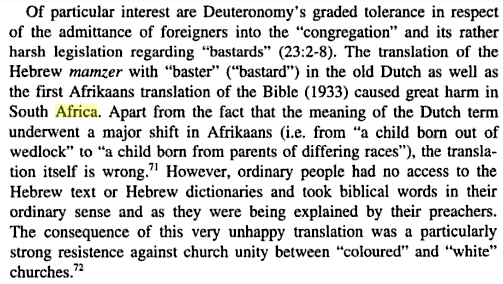
Online source of scans above here
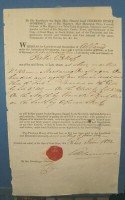 Under the religious leadership of the NGK this part of Griqualand West, bordering the Kingdom of Lesotho, was illegally occupied by a small transient population of the Boers soon after the arrival of the "bastard" Griqua (in the 1820s). The boers first needed the land for
winter grazing. This was followed by larger numbers of boers who followed
these white pioneers when conflict arose with the British who had taken over
the administration of the Cape Colony from 1795. The first major uprising
by the Dutch burghers in the Cape came in 1815 when the British government
enacted the "rule of law" over them and the second, and main reason for the
great trek by the boers through the lands around Philippolis, was their refusal
to accept the abolition of slavery in 1834, the Boers in the Cape continued
to have black slaves at this time despite the outlawing of this practice. Furthermore, the Voortrekkers sought a sanctuary where their "pure blood" could not be sullied by interbreeding with lesser mortals.
Their unfavourable view of coloured or black people did not auger well for
the (coloured) Griquas.
Under the religious leadership of the NGK this part of Griqualand West, bordering the Kingdom of Lesotho, was illegally occupied by a small transient population of the Boers soon after the arrival of the "bastard" Griqua (in the 1820s). The boers first needed the land for
winter grazing. This was followed by larger numbers of boers who followed
these white pioneers when conflict arose with the British who had taken over
the administration of the Cape Colony from 1795. The first major uprising
by the Dutch burghers in the Cape came in 1815 when the British government
enacted the "rule of law" over them and the second, and main reason for the
great trek by the boers through the lands around Philippolis, was their refusal
to accept the abolition of slavery in 1834, the Boers in the Cape continued
to have black slaves at this time despite the outlawing of this practice. Furthermore, the Voortrekkers sought a sanctuary where their "pure blood" could not be sullied by interbreeding with lesser mortals.
Their unfavourable view of coloured or black people did not auger well for
the (coloured) Griquas.
Image right: The original land title granted to Pieter Retief at Grahamstown before he embarked on the great trek with his Voortrekkers. More at this link.
Theft of Griqua lands by the boers
During the 1830s large communities of boers had moved onto the Griqua lands to escape jurisdiction under the British Government's abolition of slavery act. They started leasing the Griqua's lands in what is now the Orange Free State on a forty year basis. These leases were often struck for a bottle of brandy and very little record was kept - a recipe for disaster.
More on Scott Balson's 2007 trip to Philippolis at this link
The manner in which Griqua lands were taken from them by the Boers was not
unique. The settlers, both British and Dutch had undertaken widescape theft
of Hottentot lands across the southern part of South Africa for many generations
leaving the pure Hottentot race with a tiny outpost far to the east of Cape
Town, at Kat River. In the 1850s this Hottentot community revolted but their
last stand was easily crushed by the British and the country's indigenous
people scattered. No Hottentots survive today.

Image right: the NGK church at Philippolis now stands where the Griqua Church once stood. The Boers never repaid Adam Kok or his people for the debt on this land and the building they took in the late 1850s.
| The manner in which lands were stolen by both the British
and the Boers is summarised by Rev Christian Latrobe in his book
"A journal of a visit to South Africa" (1816).
He records on page 120: This place (Stoffels-Kraal) likewise belonged to a tribe of Hottentots, but was taken from them, by a species of robbery, very common in former days, when for a few bottles of brandy, or some other trifling consideration, the best lands in their possession were purchased of them; and the Hottentot captain, perhaps, in a state of intoxication, led to some magistrate, by whom the shameful bargain was ratified. The poor fellow did not come to his senses, till too late to recant, when he perceived with dismay, how he had suffered himself and his people to be duped. |
A legality the Griqua could never understand
Under consecutive British Governors the integrity of the Griqua lands became more and more fragile as their region was first broken into alienable and inalienable districts. The relevant treaties signed by the Griqua can be seen at this link. What made matters worse was the clause built into leases which stated that any improvements made by the boers to the leased land had to be compensated for before the Griquas could regain possession on the expiry of the lease - an impossible situation. Furthermore, the Griqua Secretary at Philippolis, Hendrick Hendricks played right into the boer's hands often drinking late into the night at a boer farmhouse where he enjoyed being "treated as a whiteman" for as long as it suited the boers - in other words, getting his signature on the sale of lands they sought.
| R Gordon Cumming's book
"Hunter's life in
South Africa" describes the Griqua people in the 1840s thus (pg91),
"They are, without exception, of an indolent
disposition, and averse to hard work of any description; much of their time
is spent in hunting, and large parties annually leave their homes and proceed
with their wagons, oxen and horses on hunting expeditions into the far interior,
absenting themselves for three to four months at a time." This was a view widely adopted by the boers who used every trick in the book to prevent Adam Kok II and his people from enjoying their traditional nomadic lifestyle. A lifestyle whose Hottentot roots were not understood or tolerated by the more powerful boer nation. As the boers took possession of more and more of the lands around Philippolis the Griqua became a captive nation surrounded by a hostile people who they had once welcomed onto their lands with open arms. |
Video below - Griqua leader talks about the fight to regain some of the lost lands in the Orange Free State today
In the late 1840s conflict between the boers and the Griquas over land was reaching a critical stage - with Sir Harry Smith visiting the country and declaring that lands currently held on a 40 year lease by the boers could become freehold for the payment of three hundred pounds in a region defined as "alienable"- while in the "inalienable" region around Philippolis the boers could not own the land but would retain possession if the Griquas could not afford to pay for the improvements made by them - an annual rental to the Griqua landowner covering the ongoing lease of the land.
It was during this time that the Republican Boer Government at Bloemfontein and to the north of Philippolis started issuing its own land titles to its burghers - abjucating the lease that had once stood between boer and Griqua landowner. This was the land they now proclaimed as the Oranje Vrij Staat (Orange Free State).
The Nederlandse Gereformeerde Kerk (NGK) played a key role in the dispossession of the Griqua from their lands. Wherever the ministers preached the Voortrekkers gathered. When Dominee Faure preached under a tree on a remote farm in 1848 in the inalienable Griqua territory south of the Riet river the spot soon became a boer outpost - in breach of the agreement they had undertaken with the British Governor Sir Harry Smith.
Images below: Fauresmith commemorative plaque to the first NGK service held under the tree, now a monument, (seen below) at Fauriesmith.


Not long after Fauresmith became a boer outpost in Griqua territory the Boer Government in Bloemfontein simply took possession of the Griqua lands south of the Riet river. This resulted in the Griqua becoming increasingly besieged by this white-centric race who despised the "bastards" and their inferior mixed blood. The British, under Sir Harry Smith, in an attempt to appease the militant boers sided with them - this would lead to the Griqua becoming a people in exile in their own sovereign lands.
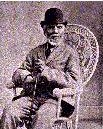 Image right: Jan Bergover, the Griqua treasurer at Kokstad
Image right: Jan Bergover, the Griqua treasurer at Kokstad
In 1859 the boers gave Adam Kok the ultimate choice - sell up your lands to the boers or fight - knowing that the Griquas had no chance of winning a war against them.
In 1861/2, most of the Griquas now under siege by the Boers at Philippolis were forced to sell out to the evolving Afrikaner nation in the Orange Free State. This was after a long and bloody conflict during which the British Governors of the Cape, who had their own agenda to appease the Boers, deserted the Griquas. To make matters worse the territory to the west of the Orange Free State was later annexed to the Cape as Cecil Rhodes' British South Africa Company sought a route to the unclaimed lands north of the Transvaal - now Zimbabwe. His Bechuanaland Border Police were based at Mafeking - more at this link. The Griquas were forced to move to NO MAN'S LAND aptly named as it was largely devoid of people following the massacre by Zulu impis (small armed bands of soldiers) of the many black tribes like the Pondos and Bacas who had earlier lived there.
Scott Balson's visit to Bloemfontein in 2007
Images below: Document in the Balson Holdings Family Trust collection - land title given to a (boer) burgher in 1898 in the Pretoria CBD (signed by Paul Kruger)
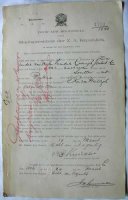 |
 |
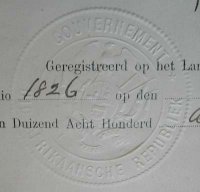 |
In a few years there would be a major dispute over the ownership of the diamond fields at Kimberley. Ironically the dispute between the Boers and the British forces to the south was over land that belonged to the Griqua.
Image right: the map overlayed by William Burchell in 1812 clearly shows that Kimberley was on Griqua land.
| Revenue stamp issued by the British for Griqualand West |
The new British colonial power's citizens started to settle up to the borders of the Orange river in places like Cradock and Colesburg as the boers and (Dutch) Voortrekkers moved inland displacing the Griquas. Below can be seen the Daniel and Hyman 2/- token coin and sizeable cheques drawn by British Colonials living in that region in the latter part of the 1800s (Balson Holdings Family Trust collection).
The Daniel and Hyman token coins |
commemorating the Boers freedom |
 |
 |
 |
Standard Bank Cradock - 1868 |
Standard Bank Colesburg - 1872 |
Standard Bank in Cape Town |
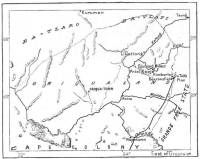 Image right: The diamond fields of Griqualand West in
1889, showing the diputed border - original map in Balson Holdings Family
Trust collection
Image right: The diamond fields of Griqualand West in
1889, showing the diputed border - original map in Balson Holdings Family
Trust collection
But more trouble was to follow for the Griquas who remained in Griqualand West. It was in the heart of the Griqua lands, at Hopetown, that the famous "Eureka and Star of Africa diamonds" were found and indentified by the larger than life personality, Dr Atherstone, starting a flood of speculators.
Speculators flocked over the Griqua Lands in 1871 with new diamond finds such as Du Toits Pan, Bultfontein, Wesselton, Koffyfontiein, Jagersfontein and, the biggest of them all, the Colesberg Kopje (later named the big hole of Kimberley) being mined. It was tales of overnight fortunes being made that created the rush of speculators which, in turn, saved the evolving boer republic of the Orange Free State from bankruptcy.
The newspaper that served the new diamond mining Kimberley community... more at this link.

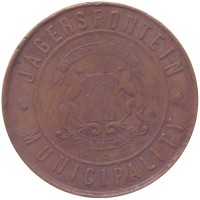 In 1913 the Jagersfontein
Municipality in the Orange Free State had 10,000 of these "three gallon"
disks made in Birmingham, to facilitate the purchase of water from the central
water pumps. The disk was pressed into a slot, a lever pulled and out came
3 Gallons of water hence the name Water Penny. In 1913 the Jagersfontein
Municipality in the Orange Free State had 10,000 of these "three gallon"
disks made in Birmingham, to facilitate the purchase of water from the central
water pumps. The disk was pressed into a slot, a lever pulled and out came
3 Gallons of water hence the name Water Penny.
Image right: The scarce Jagersfontein "Three Gallons" token issued in the early 1900s. More at this link
Scarce, (Fuld) Rarity Scale: R - 2) |
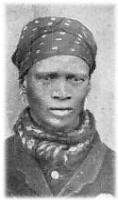
Image right: Swartbooi - the Griqua credited with discovering the famous Africa Star diamond.
It is worth noting that the spot where the big hole of Kimberley now stands was once a favoured hunting spot of the Griqua Bergenaars. Before the speculators came the area was covered in great thickets of unfriendly camelthorn trees - popular with big game like rhino, elephant and lion. The Griquas believed that the spot was bewitched and evil as a peculiar, nasty smelling mist lifted from the ground after rain fell enveloping them and the trees. This folk lore can be easily explained and ratified. As late as 1900 sulphuric fumes used to rise from the reef on the southern side of the town of Kimberley after rain.. and envelope the area in the same disturbing mist earlier experienced by the Griquas.
Scarce, (Fuld) Rarity Scale: R - 7)
Very Rare Kimberley Hotel 1800s 1/- token in VF+ (ex
Pat Moran collection)
Very Rare Kimberley Hotel 1800s 6/d token in VF+ (ex
Allyn Jacobs collection)
in the Balson Holdings Family Trust collection (common reverse)
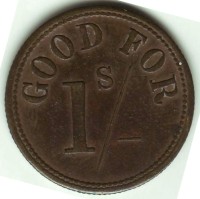 |
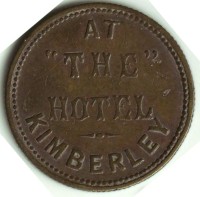 |
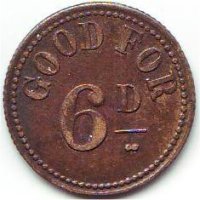 |
Scarce, (Fuld) Rarity Scale: R - 6)
The names of De Beers Consolidated Mines, Cecil Rhodes and Barnie Barnato are today synonymous with this period. The Griquas have always claimed that the land the town of Kimberley and other diamond mines stand on today was once part of their territory - a claim the Afrikaner boers and speculators disputed at that time.
Very Rare De Beers Consolidated Mines tokens in the Balson Holdings Family Trust collection
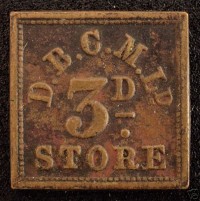 |
||
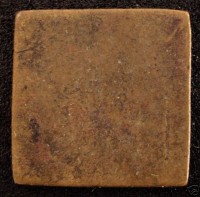 |
Reverse of 3d common to all |